This article first appeared in the November 2009 issue of THM.
By Christopher Hector
At first glance the starting list would seem to indicate that breeding for dressage is a matter of chance, since out of 54 horses entered in the Grand Prix at the European Championships in Windsor, only half, 27, are recognisably ‘dressage’ bred.
The dominating stallion is still Donnerhall, with four of his progeny at the Championships, and two by the Donnerhall sons, Donnerschwee and Don Gregory. The Hanoverian ‘W’ line is represented by the World Cup son, Wenzel with one, and the full brothers, Welt Hit IO, and Welt Hit II, by Weltmeyer out of a Hill Hawk xx mare. The older brother, IO, has one representative, while II has two. (Interestingly Carlotta, the Champion Mare of this year’s Oldenburg Elite Broodmare Show at Rastede comes from the same family of Cilla which descends from the Arabian stallion, Haladin. Cilla’s daughter Cileste is the dam of the six licensed stallions, Welt Hit IO to VI, as well as Bundeschampionate winners and no less than six foals that have gone on to compete in advanced level dressage classes.)
The Dutch stallion, Ferro, is also represented by two of his get. The other half of the starting list is a wild and wonderful mixture of would-be jumping stars and horses with the sort of pedigree that leaves you wondering what on earth the breeder was aiming at…
However the news for the future of dressage breeding is cheerier when we look at the top twenty placings in the Grand Prix, then we find that 15 out of 20 are ‘dressage’ bred. Fourteen of the 20 come from Germany: six from the Hanoverian studbook, three from Oldenburg, two from Holstein and one each from Rheineland, Bad Württenburg and Bavaria. There are three with the KWPN brand, two from Denmark, one from Sweden, and one Andalusian.
However, there is one very important proviso: the 15 dressage dressage horses all carry a good proportion of jumping blood.
The drop-dead-stand-out-star of the Championships – and winner of the Grand Prix with a record score of 84.085 – was the Dutch stallion, Totilas, by the German Trakehner, Gribaldi. The success of Gribaldi is very much the story of the transformation of the Trakehner of recent times from beauty queen to serious competition horse.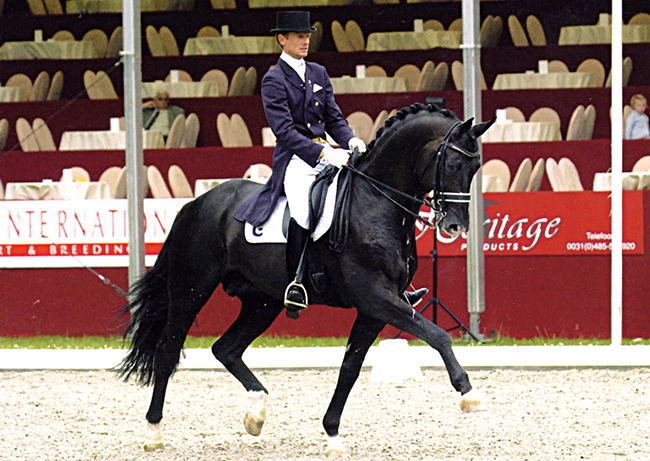
Like father, like son! Above: Gribaldi, below Totilas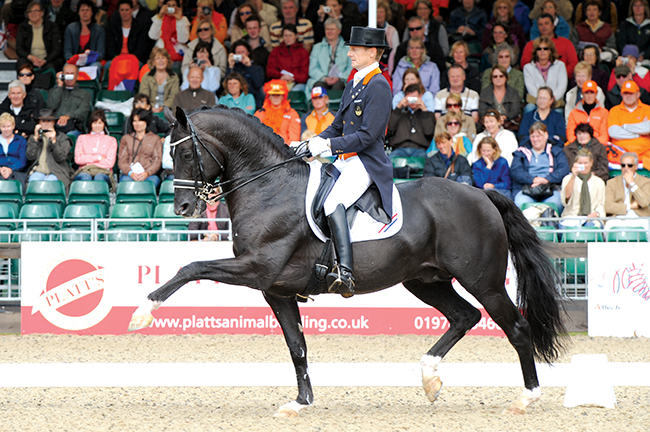
In a survey of the emergence of this ‘new’ Trakehner in The Horse Magazine, German equestrian journalist and breeding expert, Jan Tönjes observed: “As a colt Gribaldi was discovered by Otto Langels of Haemelschenburg stud. Langels is well known for his breeding policy that doesn’t necessarily go hand-in-hand with what is in vogue at the moment. Himself a Grand Prix rider, Langels was never fond of the small, handsome and beautiful Trakehners, so popular in the 70s and 80s. Horses bred at his farm are mostly not so refined. And Kostolany, Gribaldi’s sure is no exception from this rule. The black was champion stallion in 1987 and owes a lot of his popularity, not only to his offspring that show various talents (Grand Prix dressage horses, eventers and 1.50m showjumpers), but to the fact that Langels performed to the equine version of ‘Phantom of the Opera’. To the music of Andrew Lloyd Webber, Kostolany would not only do piaffes and passages but also sit and lay down. When the show was first presented at Equitana the audience was thrilled. In the past 20 years Kostolany has covered more mares from the Trakehner breeding programme than any other sire.”
But there is more to Totilas’ breeding than his Trakehner top line. On his dam Lominka’s side, we find some of the most important names in Dutch Warmblood breeding. His dam is by Glendale, a son of that mighty sire of jumpers, Nimmerdor (by the Holsteiner, Farn out of a half Thoroughbred mare), out of a mare by Marco Polo, a Trakehner stallion, imported to Holland in 1964. Marco Polo was by the Thoroughbred stallion, Poet, who stood at Celle for 22 seasons before his death in 1967. In Holland, Marco Polo became an important sire of jumping horses. On Totilas’ mare line we also find Amor, another of those Holsteiner imports that served Dutch breeding so well.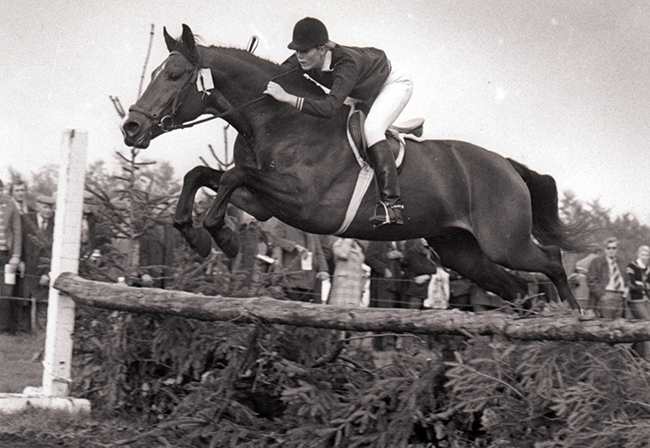
Nimmerdor was a jumper and bred jumpers but he is also turning up on dressage pedigrees
Ominously for Holland’s competitors, there are apparently five full siblings by Gribaldi out of Lominka, and Edward Gal is already referring to Totilas’ full-sister as ‘my secret weapon’.
The other superstar of the Dutch gold medal team – and winner of the Special on a record score of 84.042 – Parzival is similary bred. His sire is Jazz, a member of the Dutch dressage team at the 2002 WEG, his sire in turn is Cocktail, a Grand Prix dressage competitor with Anky van Grunsven, who was by Purioso, imported to Holland from Oldenburg and the sire of Olympic dressage and jumping horses. Purioso was by Furioso II, the French stallion imported to Oldenburg by that great breeder Georg Vorwerk. Furioso II is the founder of the modern dressage line of Florestan. On Jazz’s mare line we find the jumping progenitors: Nimmerdor and Amor.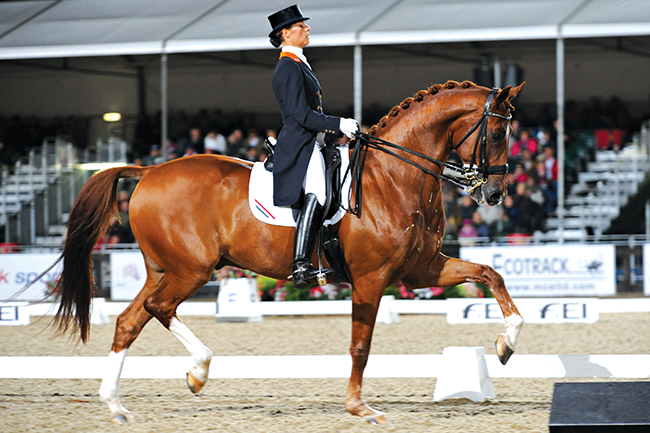
Dressage star Parzival but jumping bred on the mare line…
Furioso II’s full brother, Mexico appears on Parzival’s dam line. His son Le Mexico was imported from France to become one of the founders of the Dutch Warmblood. Le Mexico’s son, Ulft, is the sire of Parzival’s dam, Fidora. UIft is also the sire of Ferro. Filling out the dam line is Roemer, who produced dressage horses, particularly in the USA, but who is by Pilatus, sire of Westfalia’s famed jumping duo: Pilot and Polydor.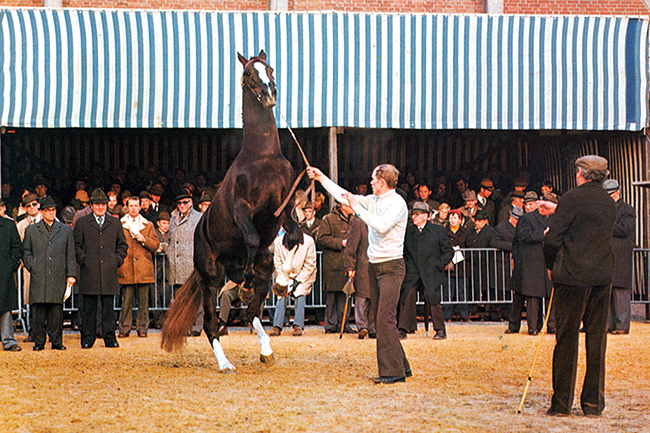
The Selle Français stallion, Furioso II was well represented at Windsor, in both the dressage and the jumping…
Apparently TC Athene, by United (by Grand Prix dressage performer Krack C out of a mare by Grand Prix dressage performer, Partout) out of Parzival’s full-sister was an absolute sensation in the 4 year old class at the Parvo Cup, this year.
It would seem that because of the pre-ponderance of jumping blood, particularly Holsteiner jumping blood, in the Dutch gene pool, their dressage breeders had no choice but to maintain a fair proportion of jump in their pedigree’s, while over the border in Germany, the dressage breeders seem to be rediscovering the importance of jumping genes.
Dr Gerd Lehrmann was the director of the Westfalien Stud for 30 years, from 1966 to 1995. When I interviewed him in 2001, Dr Lehrmann warned against too much specialisation in the stallions: “You should take care in a big breeding population that the dressage stallions can still do some small showjumps, and that the jumping stallions still have a high rideability.”
“The most important aim in Warmblood breeding is the elasticity and the balance of the movement, and the conformation of the horse. The horse must always be in self-carriage, we aim to breed a balanced horse.”
At the time I interviewed Dr Lehrmann, I got the feeling that he was regarded by some as a bit old fashioned and out of touch in his views, most people at that time were enthralled with the idea of breeding concentrated dressage lines. In the ensuing years, it would seem that the tinking is coming around to something like Dr Lehrmann’s views. Interviewed in 2007, the newly appointed director of the Hanoverian Veraband, Werner Schade was obviously thinking hard about the dressage / jumping balance. My question was:
We see breeding is getting better, and we are talking about dressage and jumping lines – but Hanover once again won the World Breeding Federation Dressage standings, yet only one of the horses in that winning dressage group – the Weltmeyer son, Warum Nicht – was bred along dressage line, the others, like Elvis and Salinero were bred to be jumpers…
“This is very interesting, I am not entirely sure about our dressage breeding. We have bred a kind of dressage horse that is very successful at the Bundeschampionate, in the three and four year old classes. They have spectacular movement, they look like trained and developed horses, but sometimes it is difficult for this kind of horse to go the whole way. It is sometimes easier for horses with average movement to make the journey to the highest level – they have a good attitude, they have a strong back, they have activity and the ability to carry their body – not pushing their body with the big movement just in front. If horses are trained properly, they will get big movement because they are able to carry their body, and they have an ability to collect – we have many examples of what we think of as jumping blood, at the top levels of dressage.”
And Warum Nicht got a very low score of 6.8 at the Bundeschampionate…
“Yes! There is a kind of specialisation that we have in the breed that we don’t need. We are a little too specialised on the young horse classes. It should be our aim to find good horses with strong backs and good activity – activity that is quick enough behind. The buyers of young horses would like to see a mature horse at a young age, and it is very difficult to bring this together, it takes three or four year olds to make a mature horse, we have to take care.”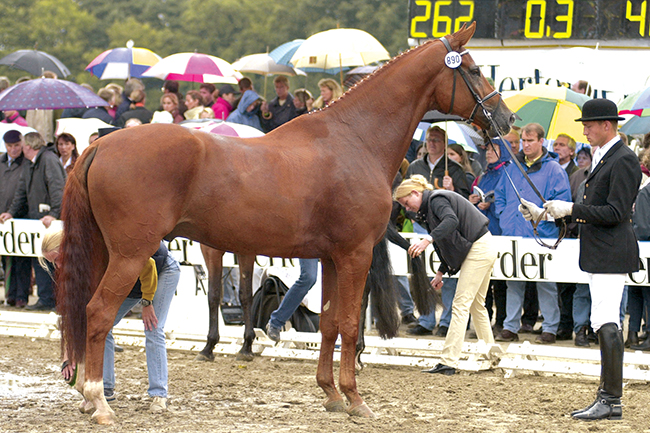
Warum Nicht – no one wanted him at the Bundeschampionate
“The philosophy for the Hanoverian breed for the future must recognise a certain degree of specialisation, but we don’t want to lose the type and the movement. We need the jumping lines to come back into dressage breeding.”
“If you look at the jumping horses, we have some horses, like the French horses, that are as far away from dressage horses as it is possible to get. They have no rideability and problems with the mouth. I am convinced that these are not the jumping horses that we need for the future.”
“We need good rideability, we need good movement. Okay, if the horse jumps, they do it in all shapes, but we are not breeding for the 20 elite riders who can ride with the ‘freaks’, we are breeding for thousands of riders: we need a horse with good rideability so it is fun to ride that horse. We must bring it together, the level of the rider and the ability of the horse. Even the jumping horses, they need a certain level of movement and rideability, and this is also an advantage for our dressage horses.”
While on the subject of jumping breeding, some mention ought to be made of the ten year old stallion, Watermill Scandic HBC, who was 8th in the Special with a score of 73.0958. He was the product of the breeding philosophy of the Dutch breeder and vet, Jan Greve. It was Greve who discovered and stood the stallions Julio Mariner, Guidam and Voltaire at his Watermill Stud in The Netherlands.
When I interviewed him in 2004, it was not long after Scandic has starred at the World Young Dressage Horse Championships in Verden, and Dr Greve was rightly proud:
“That stallion, Scandic is something special, something new. Scandic comes from a very very good jumping family. There was a Lucky Boy mare who was very good, and she had a daughter by Acteur, but the lady who owned her made one mistake, she fell in love with the Trakehner Michaelangelo – and she bred a mare – Joline – a very modern high blooded type of mare, 170cms big. I told her that I had been in Sweden, and that she should go to Amiral, he was a nice horse with a good character. She believed me, and we put in some frozen semen from Amiral and that produced the mother of my stallion. I saw Scandic’s sire, Solos Carex, as a young horse in Denmark, he was an amazing young horse, and he is still competing internationally with Tina Wilhelmson.” (He is still competing in 2009, but now as a gelding…) 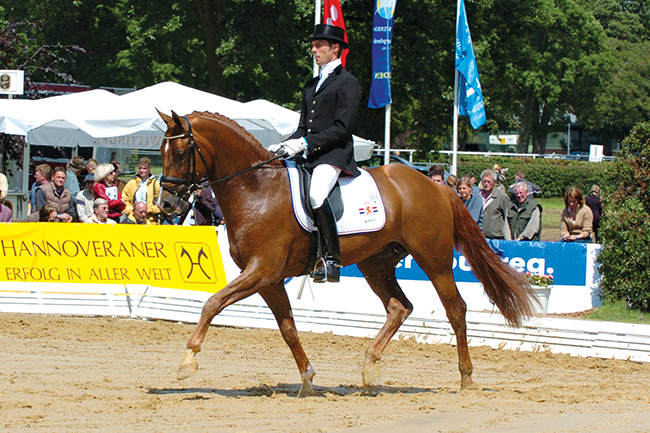
Scandic as a youngster at the World Young Horse Champs in 2004
So you were trying to breed a dressage outcross?
“I didn’t bred him in name, but I am sort of the mental father. His first name was ‘shot in the dark’, because he was twice bred to stallions the mare owner had never seen, but we changed his name to Scandic because there is so much Scandinavian blood in him.”
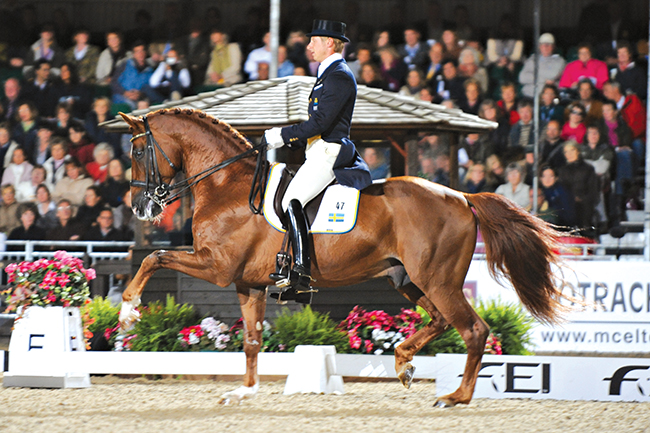 Scandic, the Grand Prix horse, competing at Windsor with Patrik Kittel
Scandic, the Grand Prix horse, competing at Windsor with Patrik Kittel
But why did you go there for a dressage stallion, rather than the fashionable D, W, R F lines in Germany?
“Because everyone does that. When I was a boy I hated going by the bus to school, eberybody standing in the same line, I don’t like that, being too crowded. I wanted to breed something new.”
“For dressage horses, you need power behind, sometimes you need those strong mares behind, don’t look always to a nice front end and forget about the hind end, they did that for years.”
The word from Holland is that Scandic is putting good young stock on the ground – although the feeling is, that he works best over more refined mares, with a good proportion of ‘blood’.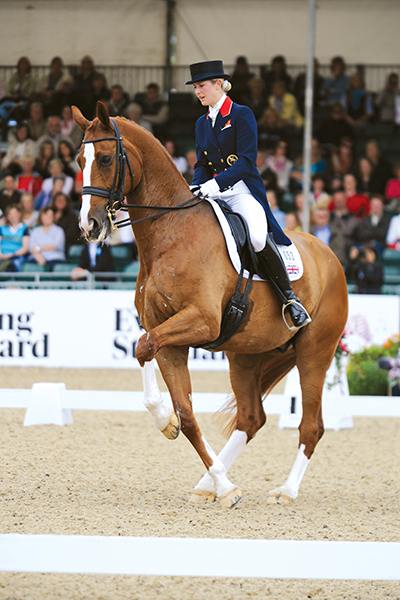
Mistrel Hojris by Michellino out of the famous mare, Virginia
Perhaps Dr Greve should not be so dismissive of the stallion, Michaelangelo, since he was partly responsible for another of the stars at Windsor, the bronze medallist, Mistral Hojris. This powerful Danish Warmblood gelding is by the Michaelangelo son, Michellino out of mare by Ibsen. Michaelangelo was crowned Trakehner Stallion of the Year in 2006, while his son, Michellino, was Danish Warmblood Stallion of that same year. Michellino is out of the Dutch mare, Claudette by Ulft. Mistral Hojris is out of Virginia, who produced a stunning total of 15 foals for the Danish breeder, Betty Rasmussen, who also bred the showjumper, Lando who won a silver medal at the Sydney Olympic Games. Virginia is by the Swedish stallion, Brabant, out of a mare by Elizar, dam sire of May Sherif, sire of the dressage superstar, Matador.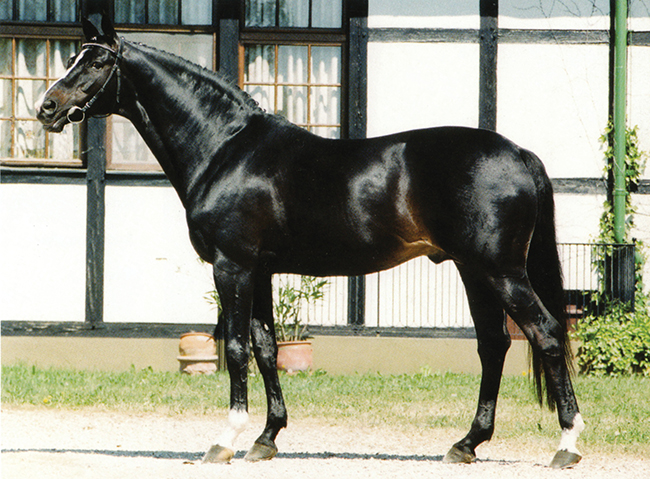
Michaelangelo – the Trakehner stallion is by the Thoroughbred, Pasteur, out of a Matadormare
Breeding for jumping, is it boring?
Unlike the dressage horses, the starting list for the jumping reveals that they are obviously bred to showjump. In the 2007-2008 edition of Monneron, Bernard le Courtois produced a list of the top 75 jumping stallions in the world, on the basis of the FEI list of the top 2515 jumping horses in international competition. He identified four main stallions: Almé, Cor de la Bryère, Capitol and Ladykiller xx.
An examination of the sires of horses entered in the European Showjumping Championships, confirms the dominance of these four lines, with perhaps the addition of the Furioso xx line.
There were 16 descendants of Cor de la Bryère (four through Corrado, four through the Caletto brothers, two through Contender); there were 10 descendants through Almé (five through Jalisco, three of them through his son, Quidam de Revel, and two through the only surviving own son of Almé, the Dutch based Animo); there were nine descendants of Ladykiller (two through Landadel); five from Furioso (two through Voltaire), and three each from Capitol, Ramiro and Polydor, and two each from Double Espoir and Laudanum xx.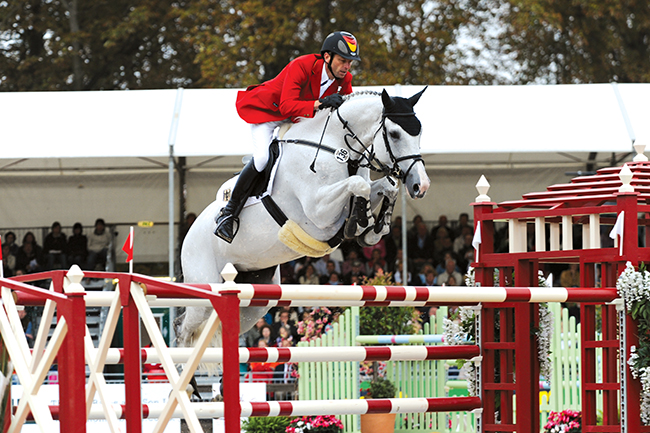
Carrying the flag for Cor de la Bryère: Corradina – silver at Windsor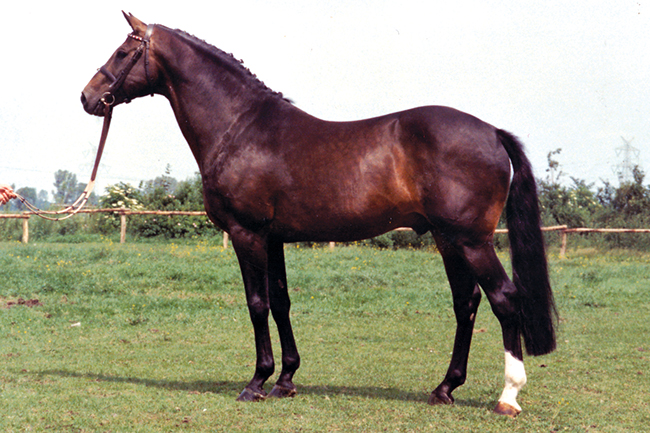
Cor de la Bryère
Furioso xx was born in England in 1939 and went on to be one of the most influential sires in modern performance horse breeding, even though he never won a single race in his 21 starts! He was also rich in Thoroughbred jumping blood – being by Precipitation out of a mare by Son-In-Law by Dark Ronald. Furioso xx was the leading sire of jumping horses in France from 1954-1961.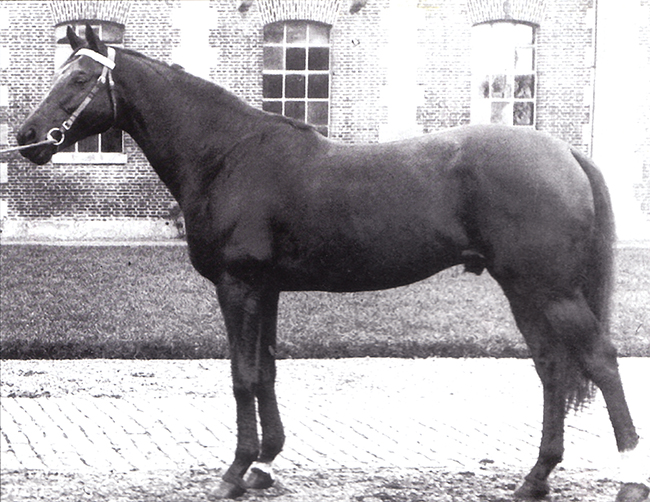
Another founding father, Furioso xx
Furioso xx had something of an advantage since his sons influenced three of the most important breeding areas: Mexico in France, Le Mexico in The Netherlands, and Furioso II in Germany and then, in the last year of his life – 1986 – at Zangersheide in Belgium.
The Cor de la Bryère roller coaster contines to roll on, nine years after his death, and the breeders in Holstein continue to succeed with a variation on a very simple formula: Ladykiller, ‘Corde’ and Capitol. If it ain’t broke, why fix it?
Obviously the jumping lines are much more consolidated than the dressage ones. It takes many more progeny to make the top ten on any of the various ‘best of’ rankings for the jumpers than the dressage sires. If we look at the WBFSH rankings for 2007 we find that the top ten dressage horses have a total of 71 representatives currently competing, and average of just 7.1 competitors per stallion. The leader on the dressage rankings, Donnerhall, has 16 representatives – however it takes a lot more successful progeny to make it as a jumping sire. Darco, in first place, has points from 46 progeny and the average number of international representatives per top ten jumping stallion is 27.2.
Give the number of performers he has produced of recent years, Darco was somewhat under-represented at Windsor, with just two, his grandson, Ulysse by Nonstop (out of a Jus de Pomme mare), and a son, Winningmood (Cassini).
The picture is much the same after the top 27 jumping horses qualify to go on for individual honours. Five descend from Cor de la Bryère, five from Almé. It appears that while the dressage world is still finding new blood and establishing new lines, in the world of jumping for the immediate future at least, it will be more of the same.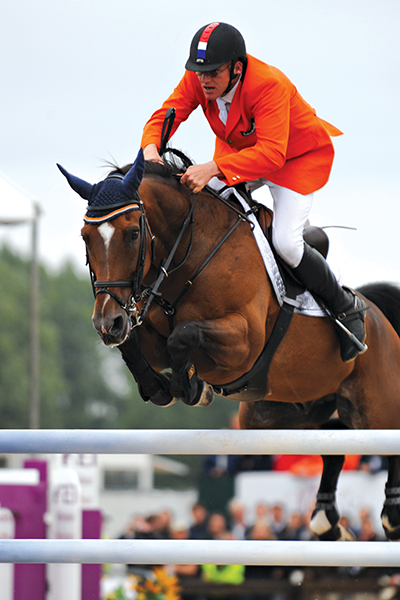
The essence of Dutch breeding – Oki Doki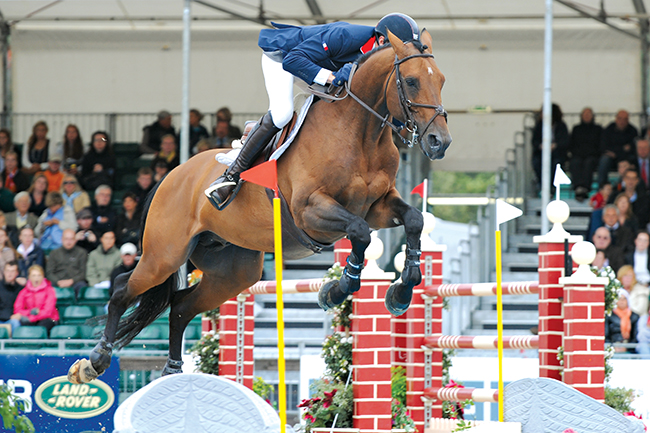
Gold for the Almé line, Kraque Boom at Windsor
The three individual medallists mirror the overall bloodlines anaylis. The gold medallist, Kraque Boom Bois Margo represents the Almé line. He is by Olisco, a son of Jalisco who is out of the Grand Prix competitor, Stella (by Nithard AA). Stella was also the dam of Quick Star. The silver medallist Casten-Otto Nagel’s mare Corradina represents the Cor de la Bryère line. She is by the Cor de la Bryère son, Corrado out of a Sandro mare. The bronze medallist Oki Doki is quintessential Dutch breeding. Oki Doki is by Jodokus, by Ramiro out of a mare of Abgar xx / Farn breeding. Oki Doki’s dam is by Marco Polo out of a Farn mare.
http://horsemagazine.horsemagazine.com

